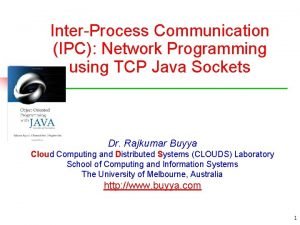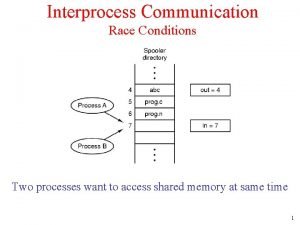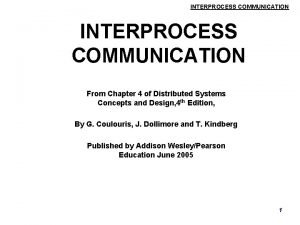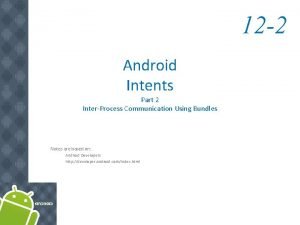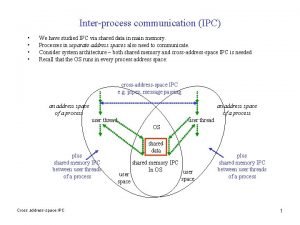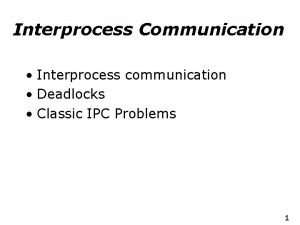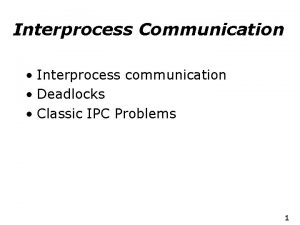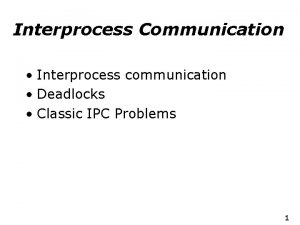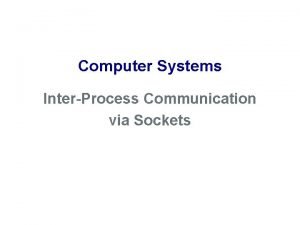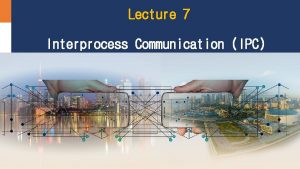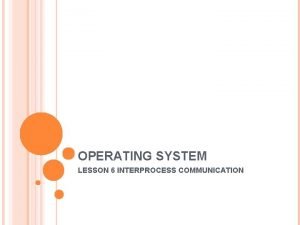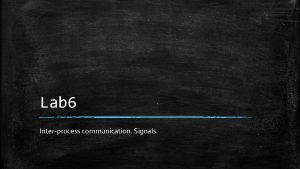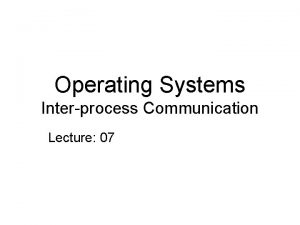Interprocess communication IPC We have studied IPC via















- Slides: 15

Inter-process communication (IPC) • • We have studied IPC via shared data in main memory. Processes in separate address spaces also need to communicate. Consider system architecture – both shared memory and cross-address-space IPC is needed Recall that the OS runs in every process address space: cross-address-space IPC e. g. pipes, message passing an address space of a process user thread OS plus shared memory IPC between user threads of a process Cross address-space IPC shared data shared memory IPC In OS user space plus shared memory IPC between user threads of a process 1

Concurrent programming paradigms – overview IPC via shared data – processes share an address space – we have covered: 1. shared data is a passive object accessed via concurrency-controlled operations: conditional critical regions, monitors, pthreads, Java 2. active objects (shared data has a managing process/thread) Ada select/accept and rendezvous 3. lock-free programming We now consider: Cross-address-space IPC Recall UNIX pipes – covered in Part 1 A case study Message passing – asynchronous – supported by all modern OS Programming language examples: Tuple spaces (TS) Erlang – message passing between isolated processes in shared memory Kilim – Java extension for shared memory message passing Message passing – synchronous e. g. occam Consider which of these might be used for distributed programming. Cross address-space IPC 2

UNIX pipes outline - revision A UNIX pipe is a synchronised, inter-process byte-stream A process attempting to read bytes from an empty pipe is blocked. There is also an implementation-specific notion of a “full” pipe - a process is blocked on attempting to write to a full pipe. (recall – a pipe is implemented as an in-memory buffer in the file buffer-cache. The UNIX designers attempted to unify file, device and inter-process I/O). To set up a pipe a process makes a pipe system call and is returned two file descriptors in its open file table. It then creates, using fork two children who inherit all the parent’s open files, including the pipe’s two descriptors. Typically, one child process uses one descriptor to write bytes into the pipe and the other child process uses the other descriptor to read bytes from the pipe. Hence: pipes can only be used between processes with a common ancestor. Later schemes used “named pipes” to avoid this restriction. UNIX originated in the late 1960 s, and IPC came to be seen as a major deficiency. Later UNIX systems also offered inter-process message-passing, a more general scheme. Cross address-space IPC 3

Asynchronous message passing - 1 address space of a process A send. Mess (ptr) address space of a process wait. Mess ( ) before send. Mess ( ) avoids buffering B . = potential delay wait. Mess (ptr) OS implementation of message passing process A’s implementation of wait. Mess and send. Mess conceptual wait. Mess ( ) message queue waiting (actually in shared messages send. Mess ( ) data area, “waiting messages”) wait. Mess ( ) may call OS_block_thread (t. ID) send. Mess ( ) may call OS_unblock_thread (t. ID) Cross address-space IPC 4

Asynchronous message passing -2 Note no delay on send. Mess in asynchronous message passing (OS buffers if no-one waiting) Note cross-address-space IPC implemented by shared memory IPC in OS Details of message header and body are system and language-specific e. g. typed messages. At OS-level message transport probably sees a header plus unstructured bytes. Need to be able to wait for a message from “anyone” as well as from specific sources e. g. server with many clients Client-server interaction easily set up e. g. needed for system services in microkernel - structured OS. A send. Mess (ptr) . wait. Mess (ptr) Cross address-space IPC B . . = potential delay wait. Mess (ptr) send. Mess (ptr) 5

Programming language example: Tuple spaces Since Linda was designed (Gelernter, 1985) people have found the simplicity of tuple spaces (TS) appealing as a concurrent programming model. TS is logically shared by all processes. Messages are programming language data-types in the form of tuples e. g. (“tag”, 15. 01, 17, “some string”) Each field is either an expression or a formal parameter of the form ? var, where var is a local variable in the executing process sending processes write tuples into TS, a non-blocking operation out (“tag”, 15. 01, 17, “some string”) receiving processes read with a template that is pattern-matched against the tuples in the TS reads can be non-destructive rd (“tag”, ? f, ? i, “some string”), which leaves the tuple in TS or destructive in (“tag”, ? f, ? i, “some string”), which removes the tuple from TS Even in a centralised implementation, scalability is a problem: • protection is an issue, since a TS is shared by all processes. • naming is by an unstructured string literal “tag” - how to ensure uniqueness? • inefficient: the implementation needs to look at the contents of all fields, not just a header Several projects have tried to extend tuple spaces for distributed programming e. g. Java. Spaces within Jini, IBM Tspaces, various research projects. Destructive reads are hard to implement over more than a single TS, and high performance has never been demonstrated in a distributed implementation. Cross address-space IPC 6

Programming language example: Erlang is a functional, declarative language with the following properties: 1. single assignment – a value can be assigned to a variable only once, after which the variable is immutable 2. Erlang processes are lightweight (language-level, not OS) and share no common resources. New processes can be forked (spawned), and execute in parallel with the creator: Pid = spawn ( Module, Function. Name, Argument. List ) returns immediately – doesn’t wait for function to be evaluated process terminates when function evaluation completes Pid returned is known only to calling process (basis of security) Pid is a first class value that can be put into data structures and passed in messages 3. asynchronous message passing is the only supported communication between processes. Pid ! Message ! means send Pid is the identifier of the destination process Message can be any valid Erlang term Erlang came from Ericsson and was developed for telecommunications applications. It is becoming increasingly popular and more widely used. Cross address-space IPC 7

Erlang – 2: receiving messages The syntax for receiving messages is (recall guarded commands and Ada active objects): receive Message 1 ( when Guard 1) -> Actions 1 ; Message 2 ( when Guard 2 ) -> Actions 2 ; . . end Each process has a mailbox – messages are stored in it in arrival order. Message 1 and Message 2 above are patterns that are matched against messages in the process mailbox. A process executing receive is blocked until a message is matched. When a matching Message. N is found and the corresponding Guard. N succeeds, the message is removed from the mailbox, the corresponding Actions. N are evaluated and receive returns the value of the last expression evaluated in Actions. N. Programmers are responsible for making sure that the system does not fill up with unmatched messages. Messages can be received from a specific process if the sender includes its Pid in the pattern to be matched: Pid ! {self( ), abc} receive {Pid, Msg} Cross address-space IPC 8

Erlang – 3: example fragment Client: Pid. Buffer. Manager ! { self ( ), put, <data> } Pid. Buffer. Manager ! { self ( ), get, <pointer for returned data> } Buffer Manager: receive {Pid. Client, put, <data> } (buffer not full) insert item into buffer and return {Pid. Client, get, <pointer for returned data> } (buffer not empty) remove item from buffer and return it to client Cross address-space IPC 9

Erlang - 4: further information and examples Part 1 of Concurrent Programming in Erlang is available for download from http: //erlang. org/download/erlang-book-part 1. pdf The first part develops the language and includes many small programs, including distributed programs, e. g. page 89 (page 100 in pdf) has the server and client code, with discussion, for an ATM machine. The second part contains worked examples of applications, not available free. A free version of Erlang can be obtained from http: //www. ericsson. com/technology/opensource/erlang Erlang also works cross-address-space, and distributed. Cross address-space IPC 10

Kilim – shared address-space message passing Kilim extends Java via annotations and static checking. A mailbox paradigm is used. concurrent process write-message call write-message ( message) concurrent process mailbox messages read-message call read-message ( ) ……. . wait ( ) • • = potential delay - after writing a message into a mailbox the sending process/thread loses all rights to that data the receiver/reading-process gains rights. Based on linear type theory. in the current shared memory implementation, threads share an address space messages are not physically copied but pointers are used i. e. mailboxes contain pointers good performance demonstrated for large numbers of threads cf. Erlang Cross address-space IPC 11

Kilim further information Sriram Srinivasan’s Ph. D research, CL TR 769 After some 12 years’ experience of developing web servers e. g. Web. Logic, Ram wanted more efficient, but safe, concurrent programming with very large numbers of threads. The work is inspired by Ada and Erlang, but extending Java gives a better chance of acceptance and use. Another motivation for Kilim was that in classical concurrency control, methods that execute under exclusion may make library calls, making it impossible for a compiler to carry out static checking of exclusive access to data. For an overview, publications and download, see: http: //www. malhar. net/sriram/kilim/ Further work is to distribute Kilim, . . among other things. . . Cross address-space IPC 12

Synchronous message passing -1 Delay on both send. Mess and wait. Mess in synchronous message passing Sender and receiver “hand-shake” - OS copies message cross-address-space Note no message buffering in OS How to avoid busy servers being delayed by non-waiting clients (on sending answer)? buffers could be built at application-level but synchronous message passing is not appropriate for client-server programming. A B . . send. Mess (ptr) wait. Mess (ptr) . Cross address-space IPC send. Mess (ptr) = potential delay 13

Synchronous message passing example – occam In occam communication takes place via named channels. IPC is equivalent to assignment from one process to another, so for variable : = expression, the destination process holds the variable and the source process evaluates the expression and communicates its value: destination process ( ? = input from channel) channel ? variable e. g. channel. A ? x source process ( ! = output to channel) channel ! expression channel. A ! y+z input, output and assignment statements may be composed sequentially using SEQ or in parallel using PAR PROC square ( CHAN source, sink ) WHILE TRUE x VAR x source SEQ source ? x sink ! x*x square x*x sink PROC is a non-terminating procedure that takes a value from channel source and outputs its square on channel sink. We might then make a parallel composition: CHAN comms: PAR square ( chan 1, comms ) square ( comms, chan 2 ) Cross address-space IPC chan 1 x square x*x comms square x*x*x*x chan 2 14

Synchronous and asynchronous systems Historically, synchronous systems were favoured for theoretical modelling and proof. e. g. occam was based on the CSP formalism, Hoare 1978 occam enforces static declaration of processes - more applicable to embedded systems than general purpose ones: “assembly language for the transputer”. Current applications need dynamic creation of large numbers of threads. In practice, asynchronous systems are used when large scale and distribution are needed. See your theory courses for modelling concurrency and distribution. Cross address-space IPC 15
 Interprocess communication in linux
Interprocess communication in linux Java interprocess communication
Java interprocess communication Interprocess communication shared memory
Interprocess communication shared memory Interprocess communication in os
Interprocess communication in os Race condition in interprocess communication
Race condition in interprocess communication Udp datagram communication in distributed system
Udp datagram communication in distributed system Android interprocess communication
Android interprocess communication Interprocess communication
Interprocess communication General relativity vs special relativity
General relativity vs special relativity If you had studied hard, you wouldn't failed the exam.
If you had studied hard, you wouldn't failed the exam. George gray poem answers
George gray poem answers Via crucis via lucis
Via crucis via lucis Via negativa
Via negativa 14 estaciones del vialucis
14 estaciones del vialucis Haz cortico nuclear
Haz cortico nuclear Via erudita e via popular
Via erudita e via popular

